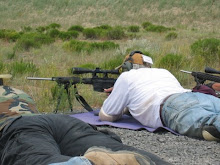As a firearms owner and user, you must take the responsibility for the safe handling and safe storage of your firearm.
You are taking the first step by reading this page, but you can go further by enrolling in any one of the numerous shooting safety courses available in your country.
Firearms safety is up to you !
1) Handle all firearms as if they were loaded!
Never forget that a gun has the potential to produce serious injury or death in a single instant of carelessness. Make safe gun handling a habit to be followed at all times. After you determine that a gun is unloaded, continue to handle it as though it were loaded.
2) Always keep your firearm pointed in a safe direction!
In selecting a safe direction, you must also take into consideration that a bullet can ricochet or glance off any object it strikes, and that bullets can penetrate walls, ceilings, floors and windows.
Remember: You should never point a gun (whether loaded or unloaded) at another person or at yourself.
3) Keep your finger out of the gun's trigger guard and off the trigger until you have aligned the guns sights on a safe target and you have made the decision to fire!
By keeping your finger completely outside the trigger guard until you are aimed at the target, you guarantee that any shots you fire will go safely in the direction of your intended target.
4) Always be certain that your target and the surrounding area are safe before firing!
Remember that a bullet can travel as much as several miles, so you should be certain of what your bullet could strike before you pull the trigger. Never fire at a movement, a noise, a flash of color or a rustling bush without positively identifying your intended target.
5) Whenever you handle a firearm, the first thing you should do (while keeping it pointed in a safe direction with your finger outside the trigger guard) is to open the action to determine whether or not the firearm is loaded!
If you do not know the proper way to open the action of a particular firearm - do not handle it. Instead, consult the owner's manual, your local gun dealer or a more knowledgeable shooter. Do not experiment
6) Thoroughly read the instruction manual supplied with your firearm!
Never use any firearm unless you completely understand its operation and safety features. If you do not have an instruction manual, contact either the retail store where you purchased your gun or the manufacturer directly and request that one be furnished to you.
7) Before firing your weapon, you should routinely make sure that your firearm is in good working order and that the barrel is clear of dirt and obstructions!
Any obstruction that prevents the bullet from moving easily down the barrel can cause pressure to build up in the weapon. A small bit of mud, gun grease, excess lubricating oil or rust can cause pressure to build up to the point where the barrel bulges or bursts upon firing, resulting in a damaged gun and serious bodily injury to the shooter or those around him.
8) Only use ammunition recommended by the firearm manufacturer, and always be certain that the ammunition matches the caliber of your gun!
Most modern firearms have their caliber designation stamped into the barrel (for example, "9x19" or ".45 Auto") Your box of ammunition should bear the exact same designation. Just because a cartridge fits into your gun does not mean it is safe to fire. Firearms are designed, manufactured and tested to standards based on factory loaded ammunition. Hand-loaded or reloaded ammunition deviating from factory specifications should not be used. Use only the correct ammunition for your firearm. Attempting to fire even a single improper bullet can destroy your gun and cause serious personal injury or death.
9) Quality ear and eye protection should always be worn when shooting or observing!
Exposure to the noise of gunfire can permanently damage your hearing if protection is not worn. Shooting glasses, preferably with side panels, help to guard against eye injuries from ejected cases and the splashback of peebles and fragments from the backstop.
Wearing eye protection when disassembling and cleaning your gun will also prevent eye injuries from loosened springs or other parts, as well as from aerosol solvents and cleaning agents.
10) Never use firearms while under the influence of drugs or alcohol!
Handling and using a firearm requires your full and continuous attention, alertness and unimpaired judgment. Avoid handling firearms while taking prescription medicines which can make you draw drowsy, slow your reflexes and impair your normal senses or judgement.
11) All firearms should be stored unloaded and secure in a safe storage case, inaccessible to children and untrained adults
12) The transportation of firearms is regulated by laws. Always transport your firearm in a safe, unloaded condition and in accordance with applicable laws.
Remember - no set of rules can cover all possible situations. The safe and rational use of a firearm depends on the common sense and proper training of the user. Always follow safety rules and think before using any firearm
FIREARM SAFETY DEPENDS ON YOU !





No comments:
Post a Comment